Campus Life - Activities - Extra-Curricular Activities
Sant Sevalal Maharaj Jayanti
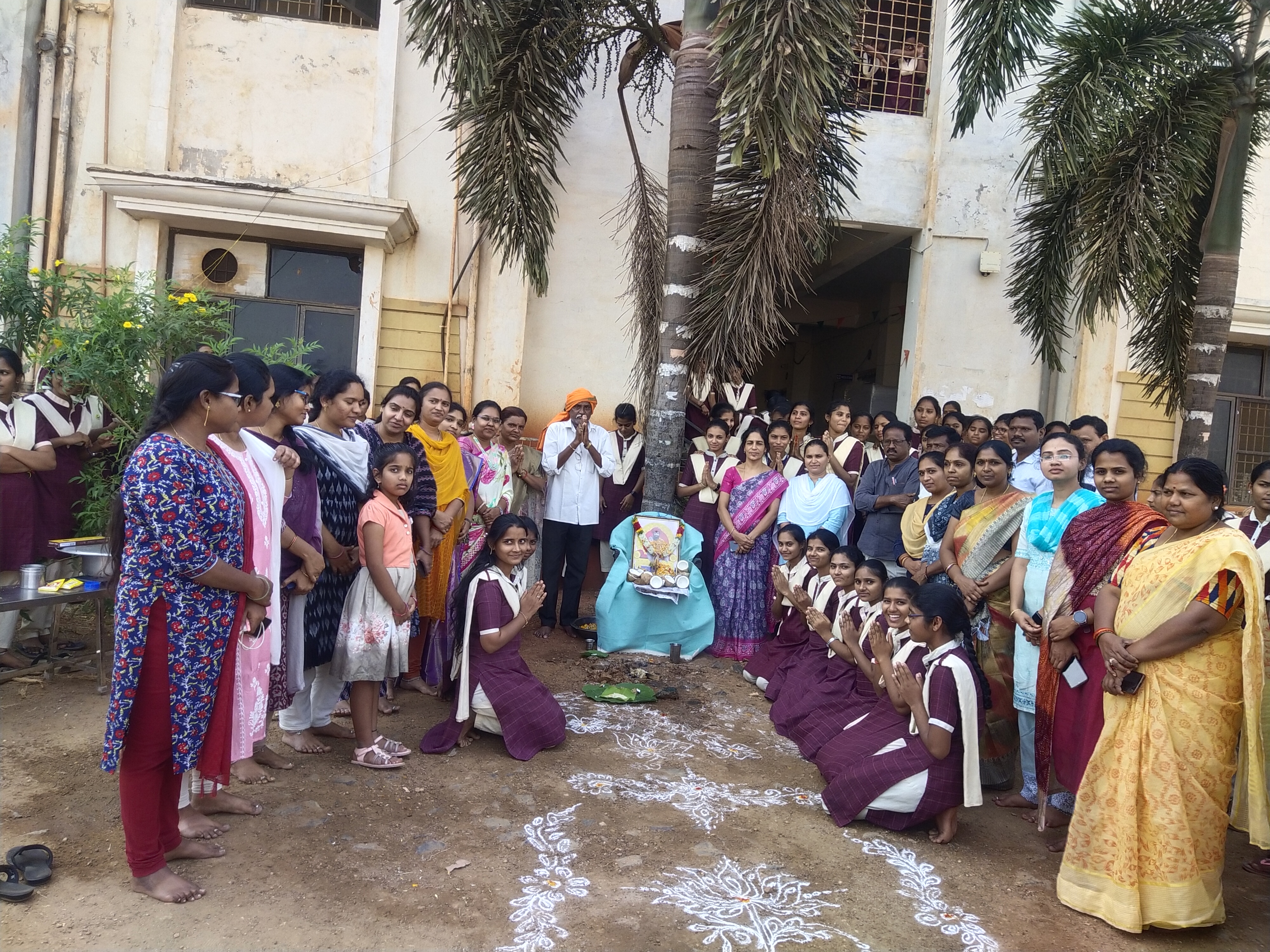
The 286th birth anniversary of Sant Sevalal Maharaj, a revered spiritual leader of the Banjara community, was celebrated with great pomp and fervour at our college on Saturday.
INDEPENDENCE DAY CELEBERATION:
India got independence on 15th of august in 1947, so people of India celebrate this special day every year as the Independence Day on 15th of august. In the event celebration, organized in the National Capital, New Delhi, the Prime Minister of India unfurled the National Flag in the early morning at the Red fort where millions of people participate in the Independence Day ceremony.
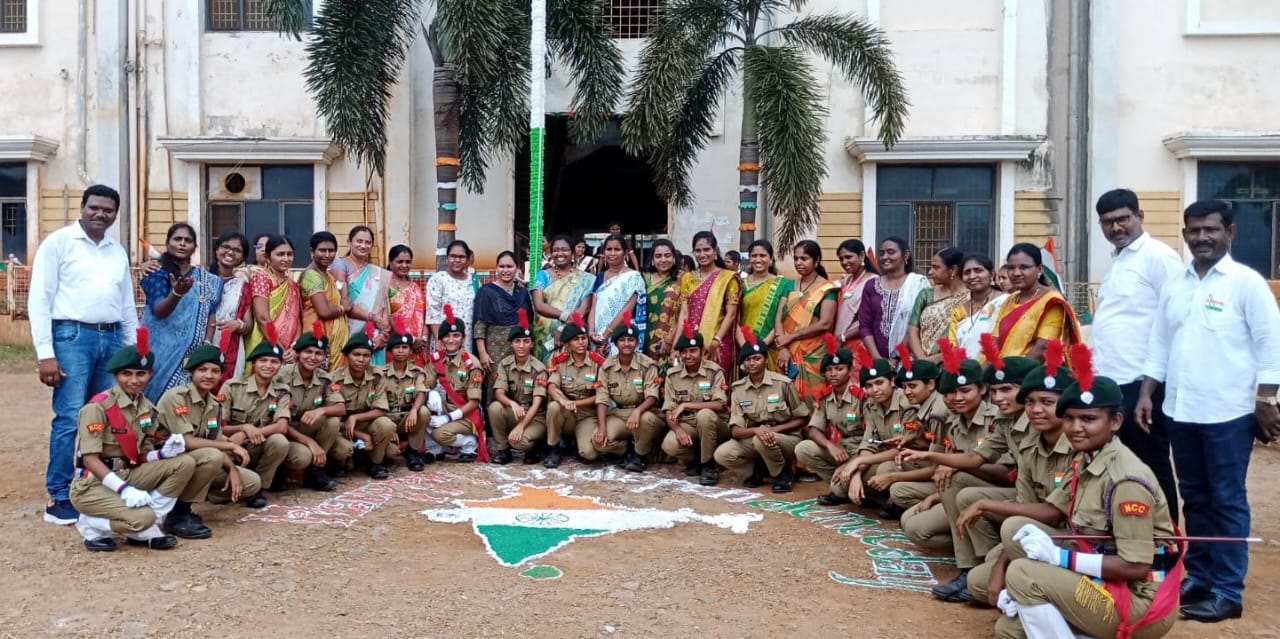
During the celebration at Red Fort, New Delhi many tasks including March past are performed by the Indian army and cultural events by the school students are performed. After the national Flag hosting and national Anthem (JANA GANA MANA) recitation, the prime minister of India gives his annual speech.
At India’s Independence Day, we commemorate all the great personalities who had played their important role in the independence of India. During the Independence Day celebration, the National Flags are also hosted in school and colleges where many activities are performed by the teachers and students.
Similarly Our college celebrated Independence day by hoistiing flag followed by cultural programmes.
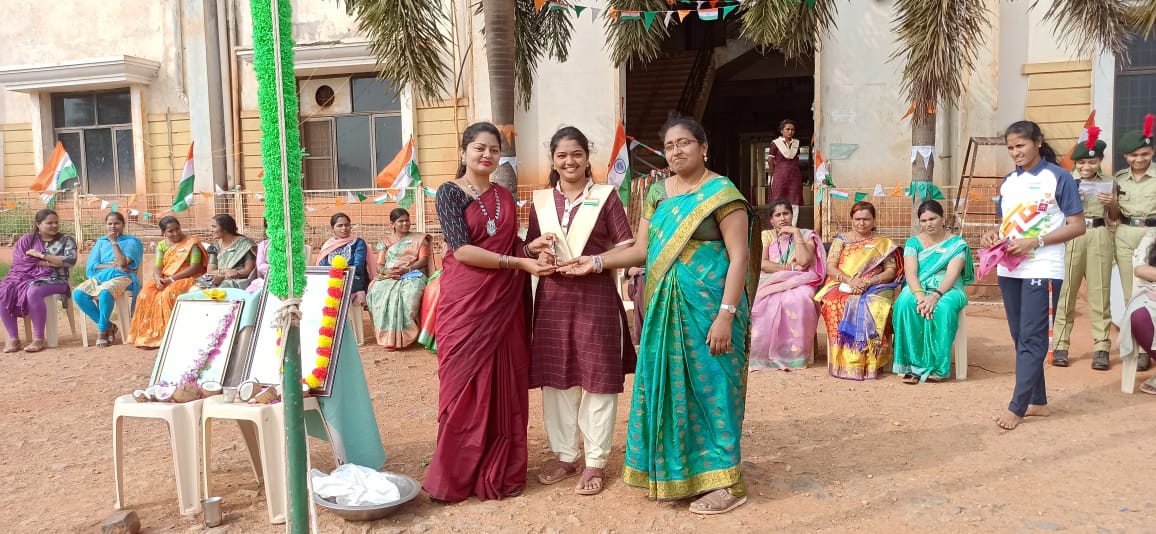
REPUBLIC DAY CELEBRATION:
India celebrates the Republic Day every year on the 26th of January since 1950 when Constitution of India came into force. Republic Day in India is of great importance in the history as it tells us all about each and every struggle of Indian freedom. People who were fighting for Independence of India took a pledge on the same day in 1930 at the banks of River Ravi in Lahore to achieve a complete independence (Poorna Swarajya) of India, which came true in the year 1947 on 15th of August.
On 26th of January in 1950, India was declared as a Sovereign, Secular, Socialistic and Democratic Republic which means the people of India has the power to choose the government for the country. It is celebrated by organizing a major event with special parade at Rajpath, New Delhi in the presence of President of India by unfurling the National Flag and singing the National Anthem.
We have celebrated republic day, inviting our Regional Coordinator as the chief guest who hoisted the flag followed by march past, and various cultural programmes, finally it ended up with prize distribution of various competitions like hair style competition, essay writing, cooking, drawing, singing, dancing conducted earlier.
HARITHA HARAM:
Telangana Ku Haritha Haram or Haritha Haram is a large-scale tree-planting program implemented by the Government of Telangana to increase the amount of tree cover in the state from 24% to 33%. 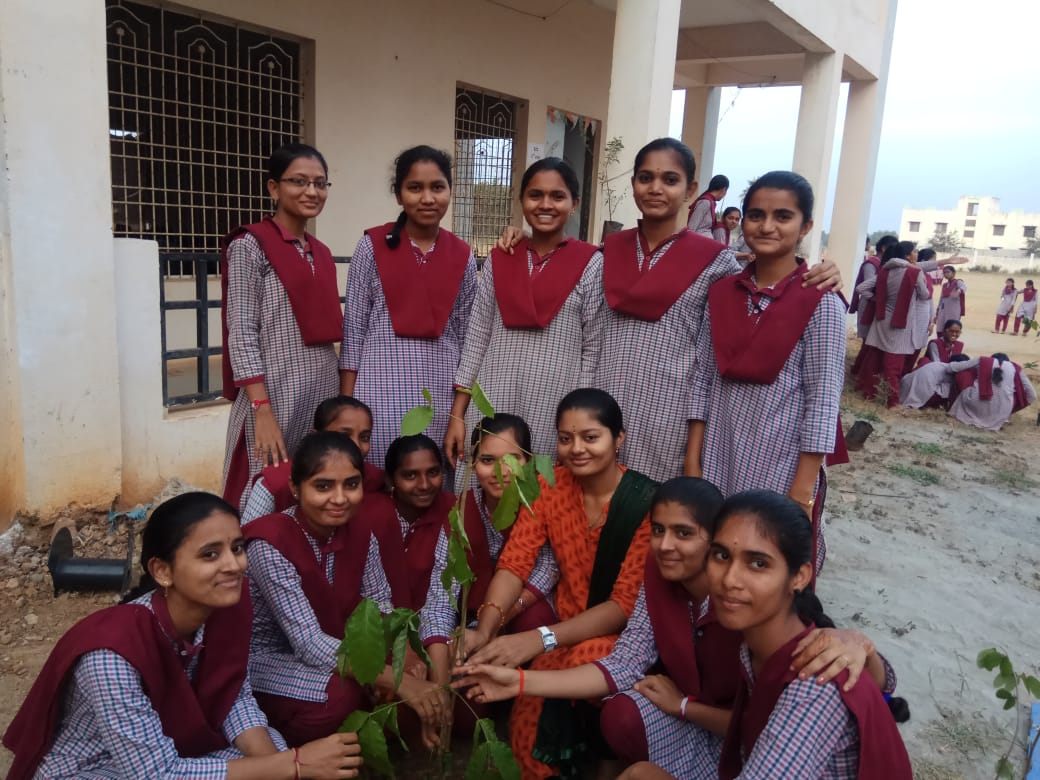
The program was launched by Telangana Chief Minister Kalvakuntla Chandrashekar Rao on 3 July 2015. It is one of the Telangana Flagship programmes to rejuvenate degraded forests, protecting these forests from threats such as smuggling, encroachment, fire and grazing. It adopted intensive soil and moisture conservation measures based on a watershed approach.
In the areas outside the existing forest, massive planting activities were to be taken up in areas such as; road-side avenues, river and canal banks, barren hills and foreshore areas, institutional premises, religious places, housing colonies, community lands, municipalities and industrial parks. The National Forest Policy of India envisages a minimum of 33% of the total geographical area under forest cover to maintain environmental stability and ecological balance, which is vital for the sustenance of all life-forms, be it human, animal.
Specific duties and responsibilities are assigned to different committees to ensure the implementation of the programme in a well designed way. These committees do regular field inspections and monitor the ongoing plantation and nursery works. The committees are the State Level Steering Committee and the District Level Monitoring and Co-ordination Committee.
At the village level, Haritha Rakshana Committees were formed to monitor the program under the Chairmanship of Gram Sarpanch.
The seedlings are monitored through geo-tagging. The Forest Department posts survival percentage details on the Department.
The program uses multiple planting models:
- Avenue Plantation – Plants will be planted along National Highway roads, State Highway roads and streets of villages and towns. Species include silver oak, kanuga, neem, raavi, marri, neredu, rain tree, gulmohar, and spathodia.
- Block Plantation – Planting will be attempted in wastelands, common lands and panchayat lands. These plantations will be raised in the vicinity of villages to meet the fuel, fodder and MFP needs. Species include albizia, acacia, sisso, neredu, sundra, chinduga, subabool and glyricidia. Planting will be performed by the concerned departments. After planting the plantations will be handed over to the gram panchayat for maintenance.
- Institutional Plantation – Planting will be done at schools, colleges, government institutions, hospitals, graveyards and private institutions and industries. Species include neem, kanuga, neredu, maredu, rela, gulmohar, raintree, badam and peltophorum. Planting will be performed by the concerned departments. Protection and watering will be the responsibility of the best institute.
- Tank Fore Shore Plantation – Planting will be at Tank Fore Shores. Species include nalla thumma, kanuga, neredu and arjuna. Planting will be taken up by the departments in charge of the mandal. After planting the plantations will be handed over to the gram panchayat for maintenance.
- Homestead Plantation – Planting will be around the houses and colonies to meet household needs. Species include Neredu, Seethaphal, Usiri, Pappaya, Guva, Neem, Maredu, Soapnut, Badam, Munaga and medicinal plants. Planting and maintenance will be performed by the residents.
- Agro Forestry Plantation – Planting will be on farmland. Species include teak, red sanders, tamarind, munaga, bombax, eucalyptus, bamboo and subabool. Farmers will do the planting and maintenance.
- Barren hill – Planting will be on barren hillocks. Species include hardy plants such as sissoo, acacia, nemali nara and kanuga. Planting will be by the concerned departments. Maintenance will be performed by gram panchayats.
OZONE DAY CELEBRATION:
September 16 was designated by the United Nations General Assembly as the International Day for the Preservation of the Ozone Layer . Ozone is a trioxygen inorganic molecule having pale blue color and pungent smell. Its formula is Oз which means tri oxygen. It is not only a molecule having pungent smell, it is the protective layer around the earth, the layer which protects the earth from different hazardous gases and attack of bursting stars in space. Scientists proved that fission reactions are continuously taking place in sun and other stars. If the chemicals, gases, and other reaction products directly reach to the earth, it will be very dangerous for the safety and survival of the earth. Mainly, ozone layer protects the earth from ultra violet rays, which are very hazardous for the earth. Ozone is therefore a very protective layer for earth.
But unfortunately, due to exceeded use of chlorofluorocarbons in our daily life. The main sources of chlorofluorocarbons are refrigerators and air conditioners. These chlorofluorocarbons are responsible for gradual depletion of ozone layer. Scientists have observed a hole in ozone layer which is alarming for the world.
So to create awareness and to acquire environmental friendly techniques to reduce the use of chlorofluorocarbons, UN general assembly proposed to celebrate world ozone day, this decision was taken in 1994, and since then world ozone day is celebrated every year on 16th September. This day is celebrated worldwide on national and international levels. Governments of different countries conduct awareness programs and ceremonies to spread the use of environmental friendly and ozone protective products. Different programs are also conducted in schools and colleges to teach young ones how to protect our world. Different activities are managed by the teachers to develop awareness in students, so they can learn the use of environmental friendly and ozone protective techniques.
Scientists and researchers proved that use of Hydrofluorocarbons in place of Chlorofluorocarbons is less dangerous, according to a research; hydrofluorocarbons have zero ozone depletion potential. Scientists have also observed that ozone depletion level has been lowering since the use of hydrofluorocarbons instead of chlorofluorocarbons.
WORLD ENVIRONMENT DAY:
World Environment Day (WED) is a campaign celebrated every year by the people worldwide on 5th of June. This campaign was established to raise the global awareness among people about the environmental issues as well as take positive environmental actions. It is handled by the United Nations Environment Programme and was established by the United Nations General Assembly in 1972. It is a day to especially focus on the current environmental conditions to make environment better.
It is celebrated by the people in more than 100 countries. It is the day when public and politicians get stimulated through awareness programs regarding environment to enhance the political attention as well as public actions. This day was created to promote people to work for environmental issues and become active agents of the sustainable and eco-friendly development worldwide.
WORLD AIDS DAY:
World AIDS Day celebrated on 1st Dec every year since 1988, is an international day dedicated to bring awareness of AIDS pandemic caused by the spread of HIV infection and mourning those who have died of the disease. The Gov and health officials and often educational organisations conduct awareness programmes etc in their vicinities. Red ribbon is the global symbol for solidarity with HIV positive people and those living with AIDS.
On dec 1st 2019 we have celebrated World AIDS Day in our college. We have conducted Essay writing and Elocution competitions on the topic The role of youth in prevention of AIDS.
NATIONAL QUIZ on WORLD MICROBIOME DAY:
World Microbiome Day, celebrated every June 27, aims to raise the profile of microbiome research around the world. This year’s theme “Diversity” creates a platform to discuss the variety of microbes, microbiome habitats and diets as feed and fuel.
Our college Botany department under the supervision of K. Sharath Deepika - DL in Botany, conducted online quiz competition on the occasion of World Microbiome Day 27th June 2020.
The theme of the quiz for this year world microbiome day is DIVERSITY - celebrating the diversity of microbes, microbiome habitats, diets to feed and fuel microbiomes and the diversity among microbiome researchers.
WOMEN PROTECTION CELL:
Every college has its own Women Cell to protect the women staff and the students from any sort of injustice or sexual harassment of any nature, directly or indirectly.
PURPOSE
The Women Protection Cell functions with the following purposes
- To make the women aware of their rights.
- To help them in knowing the importance of good health and nutrition and facilities available.
- To help them become strong and self-dependent.
- To help them in raising their voice against all kinds of discrimination.
- To help them in changing their mindset.
COMPOSITION
The Women Protection Cell of a college is generally constituted by selecting women staff as Presiding officer and members.
The names of the staff in the Women Protection Cell
The Women Protection Cell in our college interacts with students almost every day giving counselling to the needed and knowing about their problems. Students problems are addressed immediately. We have also invited Ms. Padma, a member from Women Protection Cell, Medak who interacted with students and brought awareness in them about safety and precautions they need to take and what they should do when they are in dangerous situations. T. C. Vijay kumar visited our college on 22nd of Nov, 2019 and gave counselling to our students about their safety and advised them to take the support of the Police whenever they are in danger and suggested them to Dial 100 in case of emergency.
BATHUKAMMA CELEBRATION:
Bathukamma is floral festival celebrated predominantly by the Telangana. Every year this festival is celebrated as per Shathavahana calendar for nine days starting Bhadrapada Pournami (also known as Mahalaya Amavasya or Pitru Amavasya) till Durgashtami, usually in September–October of Gregorian calendar. Bathukamma is celebrated for nine days during Durga Navratri. It starts on the day of Mahalaya Amavasya and the 9-day festivities will culminate on "Saddula Bathukamma" or "Pedda Bathukamma" festival on Ashwayuja Navami, popularly known as Durgashtami which is two days before Dussehra.
Bathukamma represents cultural spirit of Telangana. Bathukamma is a beautiful flower stack, arranged with different unique seasonal flowers most of them with medicinal values, in seven concentric layers in the shape of temple gopuram. In Telugu, ‘Bathukamma' means ‘Mother Goddess come Alive’ and Goddess MahaGauri-‘Life Giver’ is worshipped in the form of Bathukamma – the patron goddess of womanhood, Gauri Devi.
Historically, bathukamma meant "festival of life" and was celebrated to thank Goddess Parvati for her blessings for the crop harvest and income she helped generate this (current) year and again ask her blessing for the next year.
It is the festival for feminine felicitation. It is our responsibility to save our state culture. Bathukamma is biggest festival for women living in Telangana."
In our college we celebrated Bathukamma feestival with great fanfare and gaiety on before closing for Dusshra vacation. The college wore a festive look. All the students and the staff were in their traditional best with silk sarees, ghagra cholis, half sarees, falshy jewellery and men in ethnic wear.
The student cultural club and women faculty was actively involved in organising the festival in the college campus. Bathukamma was prepared with beautiful floral decorations. The students and the staff encircled the Bathukammaand danced in unison, clapping and singing to the music of lilting folk songs. It was a pleasant sight to see students wearing Telangana form of costumes in college. "
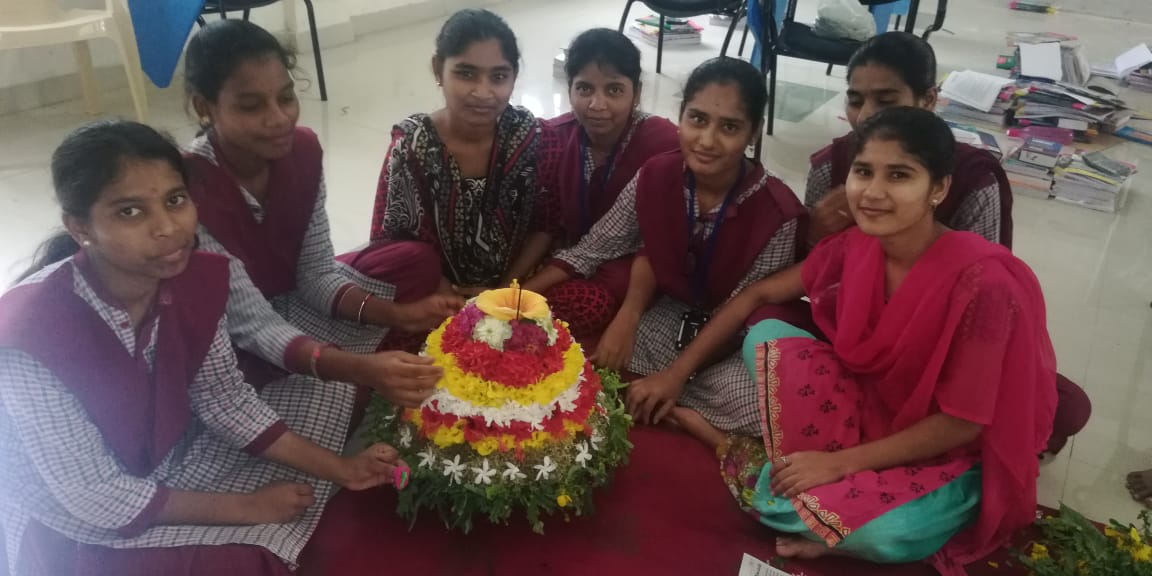
NATIONAL SCIENCE DAY CELEBRATION:
National Science Day is celebrated in India on 28 February each year to mark the discovery of the Raman effect by Indian physicist Sir C.V.Raman on 28 February 1928.
For his discovery, Sir C.V. Raman was awarded theNobel Prize in Physics in 1930.
In 1986, the National Council for Science and Technology Communication (NCSTC) asked the Government of India to designate February 28 as National Science Day. The event is now celebrated all over India in schools, colleges, universities and other academic, scientific, technical, medical and research institutions. On the occasion of the first NSD (National Science Day)(28 February 1987) NCSTC announced the institution of the National Science Popularization awards for recognizing outstanding efforts in the area of science communication and popularization.
Our college STEM Club has organised a science exhibition where we invited other college students to visit. The students visited has knwon about many science experiments by seeing the models.
